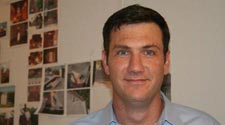Energy efficient building standards are practices that guide us towards creating structures that are indeed sustainable. Currently, different rating systems – such as LEED, Green Globes, and Society of Environmentally Responsible Facilities (SERF), to name a few – exist to hold us accountable for the ways we design, build, retrofit and operate our structures.
Another such building standard that focuses on the creation of energy efficient, comfortable, and affordable buildings is Passive House.
Volunteer Katie Schwamb recently sat down with Ken Levenson, AIA, CPHD and founding board member of NY Passive House to discuss his work and to gain a better understanding of Passive House.
.
Background:
Ken graduated from Pratt with a Bachelor of Architecture in 1989 and became a registered architect in the state of New York in 1993. He has more than 20 years experience in the industry, including starting his own Brooklyn-based practice, Ken Levenson Architect, P.C.
Getting involved with green building:
It has been an evolution in becoming active within the green building industry – specifically within the Passive House community. Achieving a balance of design, comfort, health, and energy efficiency has always been a goal in Ken’s projects and practice. A pivotal event occurred via an introduction to the Passive House building standard in 2008. Drawn to the standard’s focus on designing with similar attributes, Ken also appreciated Passive House’s focus on metrics to calculate and monitor building performance.
.
This interest in Passive House not only catalyzed Ken to take and pass the Certified Passive House Designer (CPHD) training course, but together with other Passive House enthusiasts, he founded NYPassive House . What began as a grassroots meet-up group in late 2009/early 2010 has grown into an independent non-for-profit organization “working to promote a healthy, comfortable and energy-efficient built environment through the promotion of the Passive House building standard.”
.
Additionally, experience on his first Passive House project – a townhouse retrofit in Brooklyn – led Ken and his colleagues to see a need for accessible, high-performance building materials and products here in the States. Thus 475 High Performance Building Supply was founded.
.
What makes the Passive House building standard distinctive?
Started in Germany by Dr. Wolfgang Feist, Passive House aims to “reduce the energy used to operate a building while simultaneously enhancing the occupants’ thermal comfort and raising the buildings’ indoor air quality to an unsurpassed level.”
.
“Passive House is focused on the health, comfort, durability, affordability, efficiency and predictability of our built environment.” Designers and builders focus on energy targets and air-tightness requirements primarily through optimized thermal enclosure, passive heat gains and ventilation techniques.
.
In order to be a certified Passive House, the project must undergo analysis to confirm that the building meets Passive House requirements. A tool for designing and building a Passive House is the Passive House Planning Package (PHPP) — a handbook and energy model that allows for a better understanding of the building’s dynamics
.
One similarity Passive House has with other energy efficient standards is that it can be used to design buildings of various types and size — not just houses.
.
.
Current work and future goals:
Specifically, NY Passive House is gearing up to host its first ever 2012 Passive House Symposium, an event that will include project presentations, panel discussions and a screening of Charlie Hoxie’s documentary short film, Passive Passion.
.
In general, some goals for the future include:
- Increasing awareness of the Passive House building standard itself
- Increasing the number of built and certified Passive House buildings in the New York region
- Increasing Passive House technical trainings and course types available to the public
.
Final thoughts:
“What is inspiring is seeing large numbers of architects and builders get really focused on building energy performance — and sharing ideas and experiences as they do so — and being part of that conversation.”
.
Additional resources:
- 2012 Passive House Symposium – for information on the upcoming Passive House Symposium in New York on Saturday, June 23
- Passive House Institute – for more information on the Passive House building standard
- NYPassive House – for information on the New York regional chapter
- The International PassiveHouse Association – the international network for Passive House knowledge working to promote Passive House worldwide
- Passipedia – the Passive House resource featuring a wealth of Passive House knowledge



Leave a Reply
You must be logged in to post a comment.